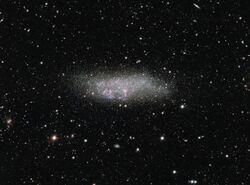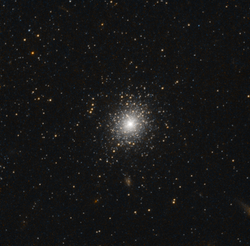Astronomy:Wolf–Lundmark–Melotte
| Wolf–Lundmark–Melotte | |
|---|---|
 The galaxy Wolf–Lundmark–Melotte (WLM), imaged by VLT | |
| Observation data (J2000 epoch) | |
| Constellation | Cetus |
| Right ascension | 00h 01m 58.1s[1] |
| Declination | −15° 27′ 39″[1] |
| Redshift | -122 ± 2 km/s[1] |
| Distance | 3.04 ± 0.11 Mly (930 ± 30 kpc)[2] |
| Apparent magnitude (V) | 11.0[1] |
| Characteristics | |
| Type | IB(s)m[1] |
| Apparent size (V) | 11.5′ × 4.2′[1] |
| Notable features | - |
| Other designations | |
| WLM,[1] DDO 221,[1] UGCA 444,[1] PGC 143[1] | |
The Wolf–Lundmark–Melotte (WLM) is a barred irregular galaxy discovered in 1909 by Max Wolf, located on the outer edges of the Local Group. The discovery of the nature of the galaxy was accredited to Knut Lundmark and Philibert Jacques Melotte in 1926. It is in the constellation Cetus.
Properties
Wolf–Lundmark–Melotte is a rotating disk that is seen edge-on. It is relatively isolated from the rest of the Local Group, and does not seem to show much evidence of interaction. However, the rotation curve of Wolf–Lundmark–Melotte is asymmetrical, in that the receding side and approaching side of the galaxy are rotating in different ways.[3]
Although isolated, Wolf–Lundmark–Melotte shows evidence of ram pressure stripping. It is far outside of the virial radius of the Milky Way, so it is possible that Wolf–Lundmark–Melotte is currently passing through some relatively dense medium.[4]
Star formation
In 1994, A. E. Dolphin used the Hubble Space Telescope to create a color–magnitude diagram for WLM. It showed that around half of all the star formation in this galaxy occurred during a starburst that started ~13 Gyr ago. During the starburst, the metallicity of WLM rose from [Fe/H] ~ −2.2 to [Fe/H] −1.3. There being no horizontal-branch population, Dolphin concludes that no more than ~20 M☉ per Myr of star formation occurred in the period from 12 to 15 Gyr ago. From 2.5 to 9 Gyr ago, the mean rate of star formation was 100 to 200 M☉ per Myr.[5] Being at the edge of the Local Group has also protected WLM from interactions and mergers with other galaxies, giving it a "pristine" stellar population and state that make it particularly useful for comparative studies.[6]
WLM is currently forming stars, as evidenced by clumps of newly formed stars visible in ultraviolet light. These clumps are about 20 to 100 light-years (7 to 30 parsecs) in size. The youngest clumps are found in the southern half of the galaxy, which has more star formation.[7]
Globular cluster
WLM has one known globular cluster (WLM-1) at 00h 01m 29.5s −15° 27′ 51″ that Hodge et al. (1999) determined as having an absolute magnitude of −8.8 and a metallicity of –1.5, with an age of ~15 billion years. This cluster has a luminosity that is slightly over the average for all globulars. The seeming lack of faint low-mass globular clusters cannot be explained by the weak tidal forces of the WLM system.[5]
References in popular culture

In E. E. Smith's Lensman novels, the "Second Galaxy" is identified as "Lundmark's Nebula".[8][9] However, some believe the "Second Galaxy" may not be the Wolf–Lundmark–Melotte galaxy, since the first chapter of the first novel in the series (Triplanetary) and the series-establishing material appearing at the beginning of subsequent novels states that the "Second Galaxy" and the "First Galaxy" (the Milky Way) collided and passed through each other "edge-on" during the "planet-forming era"—implying that the "Lundmark's Nebula" of the series must necessarily be obscured from view by the Milky Way; however, according to others, it could have passed through at an angle and thus be identified with the galaxy described in this article; some have stated that this is the galaxy that E.E. Smith was thinking of when he wrote the series. However, the distance to Lundmark's nebula is defined quite precisely in Gray Lensman as approximately 24 million parsecs, much larger than the distance to Wolf–Lundmark–Melotte (approximately 930,000 parsecs). Additionally, in Second Stage Lensmen multiple references are made to the spiral arms of Lundmark's Nebula. Wolf–Lundmark–Melotte does not possess such structures. At the time of writing of these books, the name of Lundmark was associated with such classifications and Smith may have elected to use this as a "believable" name for an entirely fictional galaxy.
At the time the Lensman series was written, most astronomers favored the tidal theory of Solar System formation, which required that planets be formed by the close approach of another star. In order to produce the massive numbers of planets necessary to evolve into galactic civilizations in both the Milky Way and Lundmark's Nebula, as portrayed in the Lensman series, E.E. Smith thought it would have been necessary for another galaxy to have passed through the Milky Way to produce the large number of close encounters necessary to form so many planets.
The Doctor Who novel Synthespians™ by Craig Hinton refers to the New Earth Republic of the 101st Century and beyond, which spearheads a programme of colonisation, sending sleeper ships to the Wolf-Lundmark-Melotte galaxy and Andromeda.[10]
References
- ↑ 1.0 1.1 1.2 1.3 1.4 1.5 1.6 1.7 1.8 1.9 "NASA/IPAC Extragalactic Database". Results for WLM. http://nedwww.ipac.caltech.edu/.
- ↑ McConnachie, A. W.; Irwin, M. J.; Ferguson, A. M. N.; Ibata, R. A. et al. (2005). "Distances and metallicities for 17 Local Group galaxies". Monthly Notices of the Royal Astronomical Society 356 (4): 979–997. doi:10.1111/j.1365-2966.2004.08514.x. Bibcode: 2005MNRAS.356..979M.
- ↑ Khademi, M.; Yang, Y.; Hammer, F.; Nasiri, S. (2021). "Kinematical asymmetry in the dwarf irregular galaxy WLM and a perturbed halo potential". Astronomy & Astrophysics 654: A7. doi:10.1051/0004-6361/202140336. ISSN 0004-6361. Bibcode: 2021A&A...654A...7K.
- ↑ Yang, Yanbin; Ianjamasimanana, Roger; Hammer, Francois; Higgs, Clare; Namumba, Brenda; Carignan, Claude; Józsa, Gyula I. G.; McConnachie, Alan W. (2022). "Evidence of ram-pressure stripping of WLM, a dwarf galaxy far away from any large host galaxy". Astronomy & Astrophysics 660: L11. doi:10.1051/0004-6361/202243307. Bibcode: 2022A&A...660L..11Y.
- ↑ 5.0 5.1 van den Bergh, Sidney (April 2000). "Updated Information on the Local Group". The Publications of the Astronomical Society of the Pacific 112 (770): 529–536. doi:10.1086/316548. Bibcode: 2000PASP..112..529V.
- ↑ (eso1610)"The Wilds of the Local Group", 23 March 2016 (Accessed 24/3/2016) http://www.eso.org/public/news/eso1610/
- ↑ Mondal, Chayan; Subramaniam, Annapurni; George, Koshy (2021). "A tale of two nearby dwarf irregular galaxies WLM and IC 2574: As revealed by UVIT". Journal of Astrophysics and Astronomy 42 (2): 50. doi:10.1007/s12036-021-09761-z. Bibcode: 2021JApA...42...50M.
- ↑ E.E. Smith (1951). Gray Lensman. Gnome. p. 66. ISBN 978-1-882968-12-1.
- ↑ Ron Ellik; Bill Evans; Al Lewis (1966). The Universes of E.E. Smith.. Advent. p. 121. ISBN 0-911682-03-1.
- ↑ "Synthespians (TM) | Discontinuity Guide | the Whoniverse". http://www.whoniverse.net/discontinuity/pd66.
External links
Coordinates: ![]() 00h 01m 58.1s, −15° 27′ 39″
00h 01m 58.1s, −15° 27′ 39″
 |


